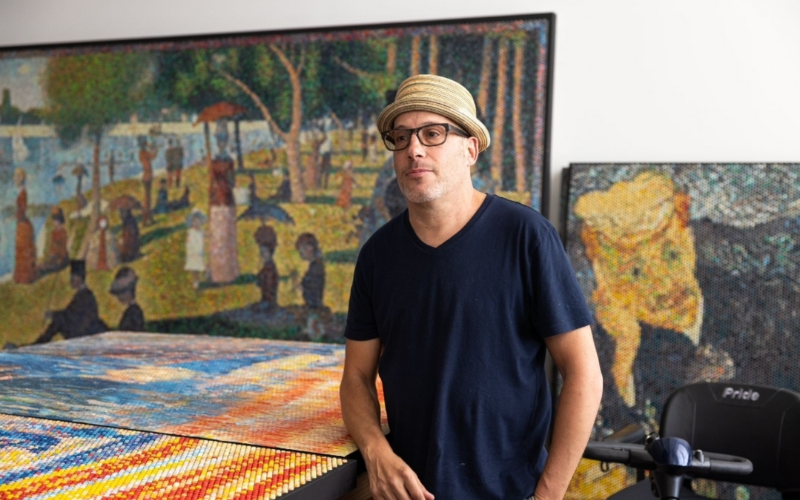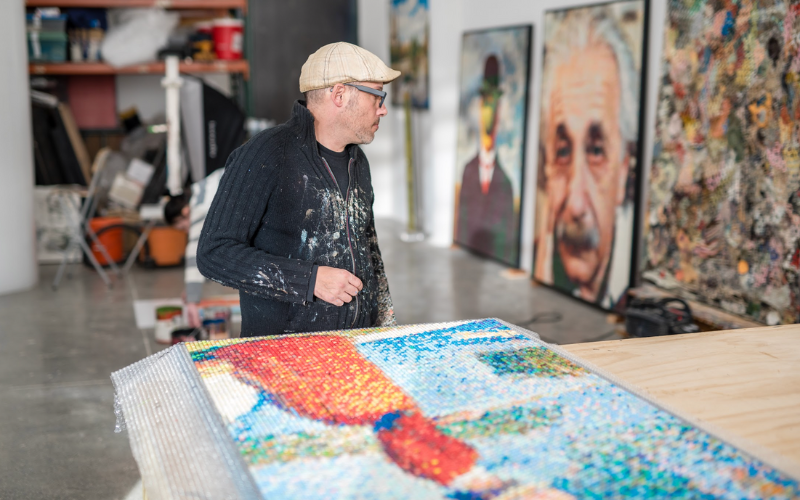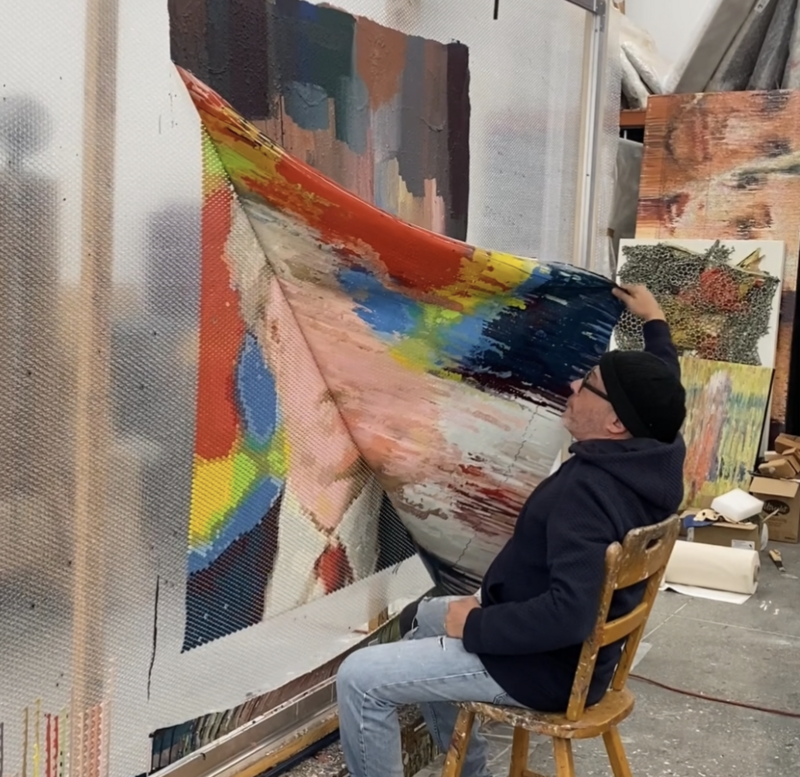Bubble wrap was never meant to be this beautiful.
Originally invented as a failed modern wallpaper in the 1950s, this unique material now lives a second life with Featured Artist Bradley Hart—as a memory keeper.
In his New York studio, Hart injects each bubble (yes, each individual bubble) with acrylic paint to build large-scale, photorealistic works from personal snapshots and iconic cultural images.
As he injects paint into the bubbles, the excess seeps out and trickles downward. But, instead of discarding it, Hart collects it, peels it away, and uses it to form derivative works: abstract echoes of the originals, full of their own emotion and energy. These paired works act like two sides of the same coin: one exacting and pixel-like, the other free-flowing and textural.
Through the lens of bubble wrap—a fragile material made to shield what we deem important—he explores what we hold onto, what we share, and how memory morphs over time.
Artwork Archive had the chance to chat with Bradley Hart about his creative process, how he began to use such a unique material, and why Artwork Archive is important to his art career.
You can see more of his work on Discovery and learn more about his art practice below:
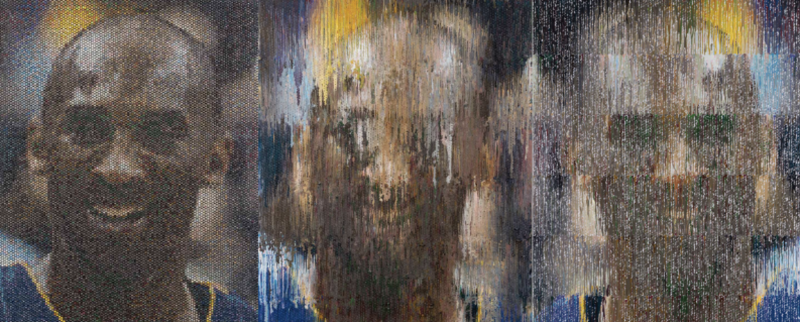
Bradley Hart, Kobe Injection, Kobe Impression, Kobe Reflection
How Bradley Hart Turns Bubble Wrap into a Body of Work
Long before the first drop of paint is injected, Bradley Hart's process is already underway. Each piece begins with a concept. Sometimes it's a new idea, other times it's an evolution of something he's already explored. Then comes the planning: he maps out the colors, stretches the bubble wrap, and gets the surface ready. And that’s just the beginning.
Then comes the part that most people recognize: Hart’s signature injection technique. Using syringes filled with acrylic paint, he injects bubble wrap by hand, sometimes using over 100 different colors in a single piece. “The paint is purposely designed to overflow,” he explains, “forming the second work—the Impression—on the reverse.” The process is tactile, repetitive, and blind. What he sees while working isn’t the image itself, but the abstract drips forming on the other side of the wrap. He doesn’t know what the Impression will look like until the piece is separated. “That reveal is a powerful experience—something I look forward to. It’s a high every time.”
What many viewers don’t realize is that each concept results in not one but three separate works: the Injection (“the father”), the Impression (“the mother”), and the Reflection (“the child”), which is made from the original color maps. Together, they form a complete narrative—but each has its own identity.
“They’re complements, not reflections.”
For this artist, the relationship between the Injection and the Impression defies simple categorization. He doesn’t see them as opposites, nor are they mirror images. “The word ‘reflection’ actually belongs to the third work,” he clarifies. The relationship between the Injection and the Impression is more complex than that. “They’re complements—inseparable and linked by origin, but with very different identities.”
The Injection is methodical, carefully constructed, and mapped from the beginning. The Impression, on the other hand, is born from unpredictability. “It’s formed by gravity and time. I can’t control it,” Hart goes on to say. “At most, I can influence the way it forms—through the rate of injection or where I begin—but it’s never controlled.”
It’s this unpredictability that gives the Impression its resonance. “It’s more impressionistic in the true sense,” he reflects. “It reminds me of how we remember things: there’s the moment something happens (the Injection), and then there’s how we retell it—sometimes days later, sometimes years. And each time we retell that memory, it changes just slightly. That constant reshaping over time—that’s what the Impression captures.”
Then, as if completing a cycle, there’s the Reflection: the "child" of both Injection and Impression. It’s built from the color maps used to guide the Injection, and while it visually references both “parents,” it carves out its own conceptual space.
Bradley Hart reveals the reverse Impression of one of his bubble wrap paintings—created from excess acrylic paint that seeps through during his injection process. Photo courtesy of the artist.
A surface full of tension and history
The idea of working with bubble wrap clicked for Bradley Hart after his first solo show in New York, XOXO. Sitting in his studio afterward, a leftover roll of the material caught his eye. It sparked a memory—one that many museum-goers know well: the warning not to touch the art.
“I started thinking about the cultural trope of ‘do not touch’ in art spaces and how viewers are so often warned away from interacting with the work,” Hart says. That constant policing around art stayed with him, and he felt compelled to engage with it directly.
He dove into research, Googling bubble wrap to learn more about the material. That’s when he discovered it was originally invented as wallpaper. That odd detail—its tactile, decorative origin—gave way to two early pieces. The first, Touch Me, was a sculptural roll made from cast resin and silkscreened with phrases like “Do Not Touch” and “Fragile,” along with the universal symbol of a pointing hand crossed out. The second, Serving My Creators’ Intended Purpose, was a cast sheet stretched over a frame, a nod to bubble wrap’s past life as wall covering.
Around that same time, Hart was also navigating a very personal struggle: living with multiple sclerosis and choosing, for over a decade, not to inject himself with disease-modifying medication. That defiance paralleled his fixation on the idea of touch denial—and, eventually, on the act of injection itself. “That resistance, paired with the idea of touch denial, is what led me to the act of injection,” he notes in hindsight—taking something medical and turning it into a means of creation.
“I approached the first works as a sculptor, casting the material in resin to create the illusion of touch without granting the experience. But eventually, I began working with actual bubble wrap—not just for what it looked like, but for what it represented.” The material became the perfect medium for exploring what it means to want to engage with something, and be denied.
What it means to create with MS
Hart has lived with multiple sclerosis since the very beginning of his bubble wrap work. And, while the condition has added complexity to his life and practice, it’s never stopped him from creating. “It hasn’t forced me to change—it’s challenged me to constantly rethink how I make work on my own terms,” the artist shares.
In the early days, the artist relied on assistants for the physical demands of the process: tasks like loading thousands of syringes with paint or helping where more than two hands were needed. Over time, that help became more integrated into his practice. “Not to step back,” Hart clarifies, “but to keep moving forward.”
Eventually, even the tools supporting his mobility became part of the creation process. “I’ve refused to let the disease limit me. In fact, I’ve begun using tools that support my mobility as tools for creating the work itself. That shift has allowed the condition to become part of the art—not an obstacle to it.”
Bradley Hart's illness isn't sidelined or hidden. Instead, it's an input. It's part of the process, part of the language, and part of what makes the work what it is.
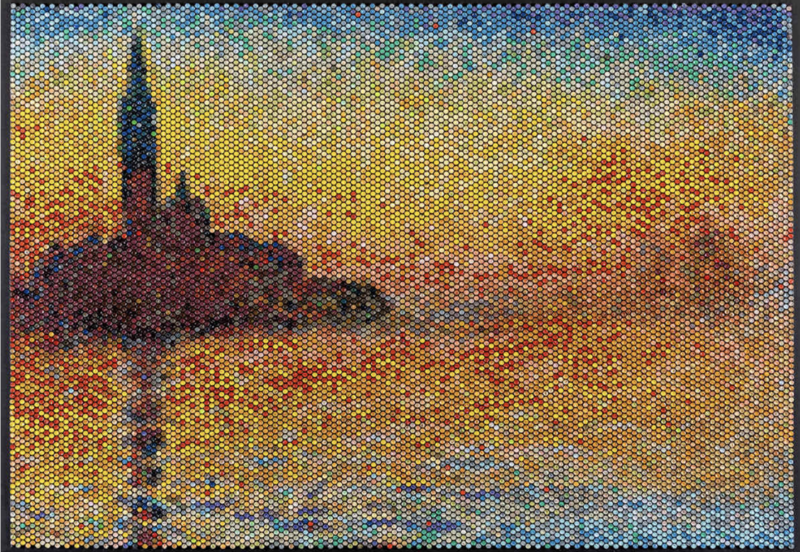
Bradley Hart, San Giorgio Maggiore at Dusk Injection, 44.75 x 64.5 in
Passion alone won’t carry you
If Bradley Hart could offer just one mindset shift to fellow artists, it'd be this: treat your art like the job it is.
“Let go of the myth that passion alone is enough,” he suggests. “Talent matters—but treating your art practice like a profession, with structure, deadlines, and strategy, is what actually builds longevity.”
The image of the artist toiling in isolation, waiting to be “discovered,” is outdated. “Obsession is great for the studio—not for visibility,” Hart points out. "Ironically, though, galleries still love to feel like they’re discovering artists, even if it’s through social media,” he adds. So for this artist, it's about being present. At events. Online. In conversation. “I’ve found it much more effective to engage naturally and let people find the work themselves—whether it’s in person or through something like Instagram—rather than pushing it on them.”
His approach? Stay in the mix, act like a professional, and let your work be discovered on its own terms.
When staying organized became non-negotiable
The moment Bradley Hart realized he needed something like Artwork Archive came early in his career. As more pieces left the studio for exhibitions and galleries (many of which had multiple locations) he needed a way to track everything.
“Artwork Archive offered that,” he says simply. “In the beginning, I really took advantage of the platform—I was entering all my works, uploading images, pricing pieces, and logging sales.”
But like many artists, the demands of making work eventually took over. “I became so consumed with the creation of the work and the day-to-day reality of building my career that I sometimes let the deeper documentation slide,” Hart admits. “Certain features, like tracking which shows a work had been in—or for how long—fell off over time, and I found myself keeping that information in my head instead of in the system.”
Still, one part of his workflow never slipped: “What never lagged was inputting the artworks themselves, their images, pricing, and who they sold to—that remained my consistent use. Looking back, I wish I had been more diligent with the rest.”
Track It While It’s Fresh:
Bradley Hart’s been there: juggling so much that some documentation slid. Exhibition details are easy to overlook, but just as important as sales. Updating them in the moment makes sure nothing gets lost in your mental archive.
Pro Tip: If you're already tracking inventory, add show history next time you update a piece! It will save you from having to go back and try to remember all the details later.
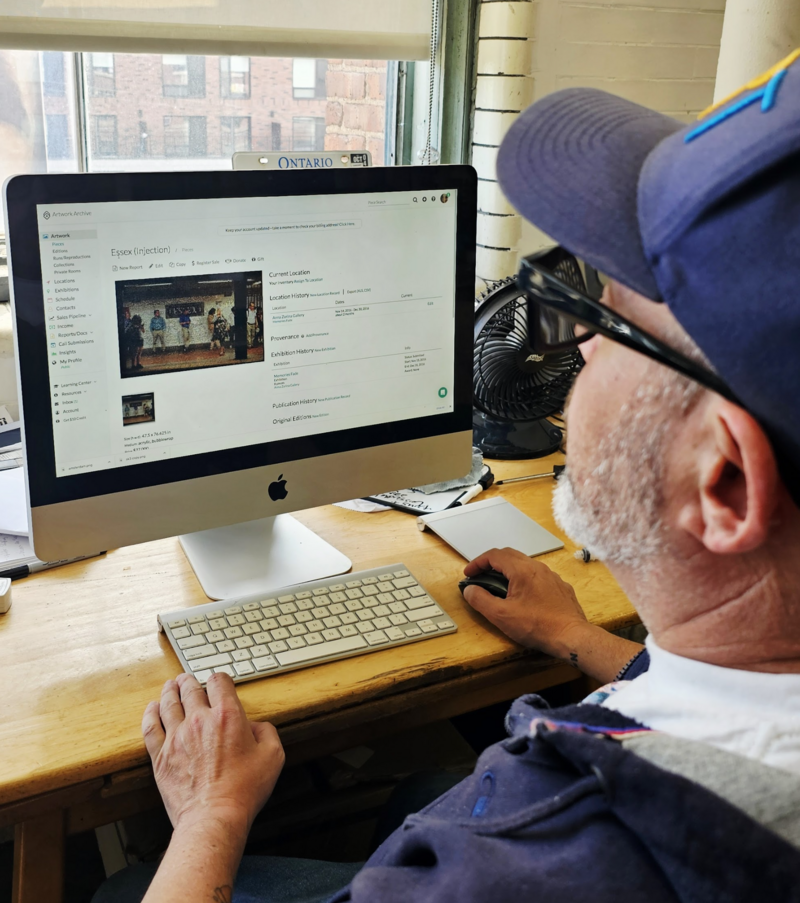
Bradley Hart uses Artwork Archive in his studio to track his inventory, sales information, an exhibition history for his injected bubble wrap artworks. Photo courtesy of the artist
Tools that meet you where you are
Out of all the features Artwork Archive offers, one has remained a staple for Hart over the years: "real-time access to my inventory."
That consistent access has served him in all kinds of moments—at shows, at events, even mid-conversation. He’s kept the basics of his inventory up to date: what’s available, what’s sold, and for how much. “If I met someone at an event or was showing work on my phone, I could check availability on the spot and immediately send them a clean, professional Portfolio Page for the specific piece or group of works they were interested in,” he explains. “It allows me to respond in real time while still looping in my gallery when needed.”
He's also started experimenting with Private Rooms, and is learning "how powerful they can be for creating more curated, in-depth viewing experiences for collectors and curators." For Hart, it’s just another example of how the platform can meet him where he is, whether that’s streamlining the basics or elevating a private preview.
Share Work Instantly With Portfolio Pages or Private Rooms:
Someone interested in a piece at your next event? Don’t scramble for a Dropbox link. Pull up a polished Portfolio Page, or curate a Private Room and send it on the spot.
Create one now and see how easy it is to share.
Make the work yours—then keep track of it
Bradley Hart doesn't sugarcoat anything for other artists. "Find your voice," he advises. "You're standing on the shoulders of others, yes—but your job is to say something only you can say." Pull from your influences, but filter them through your lens until the work becomes something entirely your own. "That's how the work becomes real."
He also stresses the importance of documentation (especially from the beginning). “I’ve found myself playing catch-up on the movement and exhibition history of earlier works simply because I didn’t consistently log those details when I should have,” the creator acknowledges. “Even if you’re focused on the creation itself—as you should be—taking a few minutes to track your pieces, your pricing, and your progress will save you years of backtracking.”
And perhaps most importantly: let your work unfold on its own terms. “Don’t try to force your work into spaces where it doesn’t belong,” the artist cautions. “Be present, be curious, surround yourself with the right people, and let your work speak—when the time is right, it will.”
Build Your Archive From Day One:
Bradley Hart admits he didn't track everything early on, and that it made things harder down the line. So start logging your artwork the moment it leaves your hands (or even earlier). The sooner you build the habit, the stronger your archive becomes.
Create your first entry right now and build that habit to support your practice.
